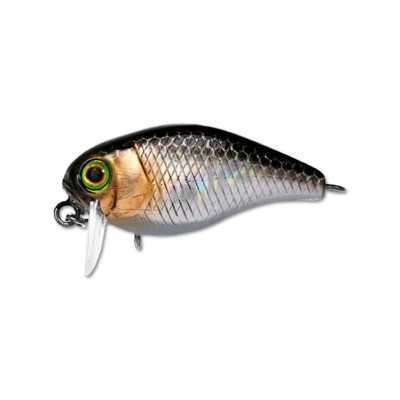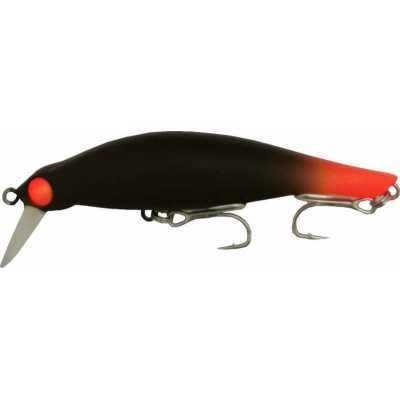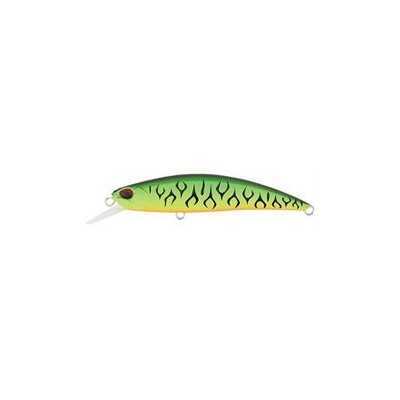Plastic / Wood Hardlures
The prototype of the modern wobbler was developed by American beekeeper James Heddon. One day in 1894, Mr Heddon was resting by the dam of an old mill, planing wood. When he returned home, he threw the waste into a pond and saw large American bass attacking the shavings bobbing on the surface. Intrigued by the fish's behaviour, Heddon started experimenting with wooden lures. In 1902, he obtained a patent for a new fishing lure, the Dowagiac. The Heddon Lucky 13 lure, developed in 1920, was a huge commercial success in the US market and in 1932 Heddon and Sons produced the world's first plastic wobbler, named 'spook' for its numerical body. And the wobbler revolution in Europe began when Finnish fisherman Lauri Rapala carved his first wobbler out of pine bark in 1936. Lauri Rapala's first Original Floater wobblers, although slightly modified, are still popular today. Lauri Rapala's historic contribution is that he was the first to invent the tongue, which makes the lure oscillate and descend to a certain depth.
The wobbler is the most modern spinning lure
What is a wobbler and how is it classified? A wobbler is a lure made of wood or plastic, usually imitating a fish, but can also imitate a reptile, insect or other predator. Wobblers are made by hundreds of companies and come in so many models that it is difficult to classify them neatly, but they are most often categorised according to the shape of the body and the level of buoyancy. Wobblers can also be tongued or untongued, single or multi-tongued. Wobblers have been divided into several categories over time, based on body shape, presence or absence of a tongue, body integrity, diving and other characteristics: minnow - elongated with a tongue; crank - a round-shaped "bubble" with a tongue; shad - midway between minnow and crank; popper - surface, elongated, without a tongue, but with a convexity at the front so that it will pop when pulled at the surface of the water; rattlin - a flat shad, without a tongue and sinking fast, pulled by an active shake, and with a rattlesnake inside; vibe - similar to a rattlin, but more elongated and silent; walker - elongated, also superficial, without tongue; jerk - flat, usually shad-shaped, without tongue; swimbait - a two- or three-part wobbler without tongue, usually imitating a natural fish that has grown up; johnny - like a minnow, but made of two or more parts, with tongue. There are many variations of these groups, but they are not very popular with us, so we won't go on about them. The wobblers are divided according to buoyancy into: top water - floating only on the surface of the water; floating - when pulled, thanks to the tongue, they dive deeper, but during the pause they rise to the surface, i.e.., lighter than the water; neutral buoyancy (suspend) - stays at the same depth as the water during the pause, i.e. weighs as much as the water; slow sinking - slightly heavier than the water; sinking - much heavier than the water. Wobblers also come in silent and rattling versions, with rattling balls built into the inside. Rattling wobblers are usually made of plastic, but Rapala has also made wooden wobblers made of balsa wood with rattles inside (Rapala Tail Dancer series).
Wobblers are the perfect bait for both spinning and velke fishing.
In Lithuania, wobblers are used to catch all predators and even peaceful fish. Wobblers can be fished in two ways - spinning or trolling. When spinning for pike, the most popular wobblers are minnow-shaped, with a neutral buoyancy of 11-13cm in the twitching mode, where the wobbler is moved by the tapping/pushing of the bait with the spinning rod's bow/bow. Japanese wobblers such as ZipBaits Orbit, OSP Rudra, Shimano Bantam, Lucky Craft Pointer, etc. are the most popular when fishing this way. Another very popular wobbler is the heron. The most common way of catching herring is with small Crank-type floating wobblers weighing between 3 and 7g. In summer, SSR (Super Shallow Runner) crankbaits are the most popular, as they dip only a few centimetres and slowly swim to the surface. In early spring or autumn it is more common to fish with spawning crankbaits or even shad/minnow-shaped small wobblers. Jackall Chubby SSR and SR, Pontoon21 RedRag, Imago Lures crankbaits and hornets are the most popular wobblers for shad. Pontoon21 Crack Jack 48SP Sr. Similar mini wobblers are also used for trout in streams. For this, 4-6cm minnow wobblers are usually used, and in midsummer the same minnow crankbaits. The most popular wobblers for trout are Pontoon21 Crack Jack 58sp Sr, Jackall Timon 55s, Jackson Trout Tune 55s. The very well priced cheap HMG Jager and Silent Assasin are also appreciated by anglers. Following on from the red fish, salmon or bream, wobblers are also the most common for anglers. This is done with minnow or shad-shaped wobblers, both floating and slow-sinking. These lures are usually 7-9cm long and weigh around 10g, with a maximum draught of around 1.5m. The most popular salmon models are Jackall Timon 88MD, Jackson Rogos 80, Pontoon21 Crack Jack 78SP SR, Shimano Cardiff Flugel 70F. Another toothless predator in our rivers is the salmon. It used to be caught only with shiners, but for about ten years now it has also been attracted by wobblers. And the further we go, the more the wobblers outperform the shiners. The wobblers used for salmon are usually minnow-shaped, about 7-10cm, long-ranging and shallow-diving. They can be sinkers, suspenders and floaters. Salmonids are also caught with popper wobblers, walkers and other fishless plastic lures. The most popular salmon lures are Shimano Cardiff ML Bullet, DUO Ryuki 70 and 80, Shimano Ecsence Shallow Assasin 99. Sturgeon are mostly caught with wobblers in the seedbeds, in the dark of the day with shallow spawning 7-10cm minnows. The most popular models for sturgeon are Pontoon21 Greedy Guts 77sr, Pontoon 21 Crack Jack 78 sp sr, Shimano Cardiff ML Bullet. An equally popular way of catching predators with wobblers is trolling, where a boat is rowed, a 20-50m section of line is released and the wobbler is pulled by the boat's engine rather than the reel. The most popular catches among trollers are pike, sturgeon and catfish. Pike are trolled with a wide variety of wobblers, the choice of which depends very much on the season and the body of water. Pike can also be trolled in shallow lakes, rivers and large ponds, lagoons and brackish lakes. So trying to identify the most popular wobblers for pike is really difficult. However, we would probably not be wrong to say that Rapala wobblers are also the most popular for pike trolling, as sturgeon and catfish are by far the most commonly caught with this legendary brand. It is much easier to name the wobblers used for sturgeon. When fishing for sturgeon at depths of 4-5 metres, the most popular are the deep Rapala Shad Rap SR07 and SR09 and the Deep Tail Dancer 07. When trolling at 6-8 metres - Rapala Deep Husky Jerk 12, Rapala Deep Tail Dancer 09, Bomber Deep Long 8,9cm. When trying to storm depths of 9m and more, the most common choices are Rapala Deep Tail Dancer 11, Bandit Walleye Deep 12, Bomber Deep Long 11cm, Rapala Deep Husky Jerk 14cm. The most coveted catch of every troller, however, is catfish. Recently, the population of this fast-growing predator has clearly recovered and is being caught more and more often. Catfish are most often trolled in the Nemunas and the Kaunas Marias. In the Nemunas (below Kaunas Hydroelectric Power Station) the best lures for catfish are Rapala Shad Rap 09, and in the Kaunas Lagoon (Nemunas) above Piliuona - Rapala Scater Rap Tail Dancer, Bomber Deep Long 11, Rapala Deep Tail Dancer 11, and Rapala Scater Rap Tail Dancer, Bomber Deep Long 8.9. Are there any winter wobblers? Yes - it is a wobbler without a tongue also called a vib. It is used for vertical fishing in winter and casting in summer. Pike, sturgeon and larger perch like it very much, especially in winter and under ice.
Wobbler online from China cheaper. Is it worth it?
There is no single answer. You can find copies of Chinese wobblers online for 2eur and Japanese ones for 25eur. This, as experience shows, is not a good wobbler for 2 euros, but for 5 euros there are some really worthy and popular ones. The Akara Ablet salmon wobbler, for example, is a really good wobbler and its price is only 4,5eur. However, the price of the original wobblers is not exorbitant. Expensive wobblers have more reliable casting systems, better paintwork and a stronger body. Cheap Chinese wobblers are like a lottery. One lure that looks the same may work perfectly well, while another seemingly the same will be half a gram heavier or have a slightly crooked tongue and turn out to be completely unwatchable.
Wobblers online at good prices
Our online shop www.azukle.lt has a huge selection of wobblers and we have them all in stock in our physical shop. This is probably the largest range of wobblers (for pike, salmon, trout, etc.) in Lithuania and we can deliver them within 1-2 working days. We don't sell from suppliers' warehouses like most e-shops do, so you won't have to wait weeks for your wobblers. You can also buy most models at a discounted price - whether they're big or mini.



































